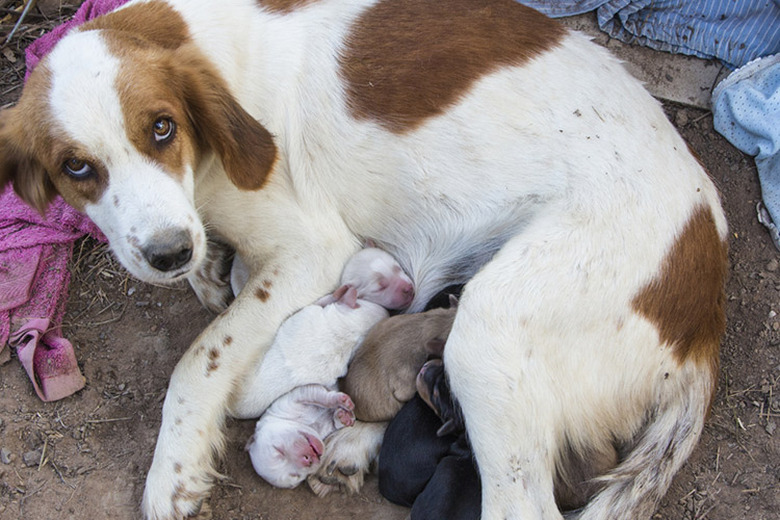Moving Newborn Pups From Outdoors To Indoors
Dogs have been giving birth outdoors for thousands of years, and some do just fine outside. However, moving the litter indoors may be easier on your furry friends. Moving the litter indoors keeps mama and her puppies out of the elements and lets you keep a closer eye on the litter in the event of illness or injury.
Preparation
Set up a room or quiet area in your home for the litter. Choose a spot with little foot traffic and minimal noise where mama and litter can rest undisturbed. A spare bathroom or laundry room is suitable.
Prepare a whelping box before moving the litter indoors. A whelping box is designed to protect puppies during birth and throughout their first few weeks of life by containing them and helping them stay warm. Place a plastic kiddie pool on the floor and line the bottom with old towels or blankets. Place a heating pad on one side of the pool and cover it with a towel. Puppies have difficulty regulating their body temperature, and the heating pad will warm them if the mother leaves the whelping box.
Acclimation
Pet every puppy in the litter as soon after birth as possible to acclimate them to human touch. Wash and dry your hands, and run your fingers lightly over the puppy's body. Touch him from head to tail, moving slowly and carefully to prevent startling the pup. While some handling newborn animals too early may lead to the mother rejecting them, this is an exception rather than a rule in the case of dogs. In fact, your early imprinting will prevent the litter from being fearful of humans as they grow up, but don't overdo it; the litter still needs plenty of alone time to bond with their mother.
Visit the Vet First
If you can, you should take the pups directly to the vet first for an examination, to see if any of the pups or the mother need immediate medical attention. Place a cardboard box in your car (or somewhere near the litter if you can't get to the vet right away) and line the bottom with a blanket. Cover one hand with a towel, and gently slide the covered hand under one of the puppies. Wrap the free ends of the towel around the puppy to keep him warm, and place your other hand on top of the pup, and pull your hands to your chest. This will keep the puppy warm and prevent you from dropping him as you carry him to the box. The mother may follow you as your carry the puppy, but that is normal as she keeps an eye on her baby.
Set the puppy in the cardboard box, and cover him with the blanket as you carry the remaining puppies to the car. Lift the blanket as you set the other puppies in the box, covering them all to keep them warm. Lead the mother to the car (or box), and if she'll fit, assist her into the box with the puppies.
Take the female and her litter to the veterinarian. He/she will give each pup a thorough examination and make sure all the pups are thriving and healthy. The vet will also check the mother to see if she is in good condition and producing enough milk to feed her puppies.
Open the car door, and lead the female into the house once you return from the vet.
Whelping Box
First, place the mother in the room with the whelping box, and close the door. Carry the cardboard box containing the puppies into the house and set the box next to the whelping box. Uncover the puppies, and slide your hand under the closest puppy. Cover the puppy with your free hand, and set it on the towel-covered heating pad inside the whelping box. It is important to read the heating pad instructions carefully and use the lowest setting to avoid overheating. Also, never leave the pad on unattended. Transfer the rest of the puppies to the whelping box, and allow the mother to examine and settle down with her puppies. Offer her a few treats to calm her down and show her the box is a safe place for her puppies.
By Louise Lawson
References
ASPCA: Newborn Puppy Care
Chelsea Collies: The Newborn Nursery
About the Author
Louise Lawson has been a published author and editor for more than 10 years. Lawson specializes in pet and food-related articles, utilizing her 15 years as a sous chef and as a dog breeder, handler and trainer to produce pieces for online and print publications.
